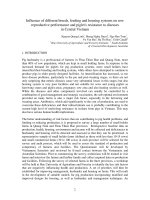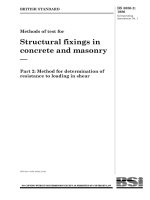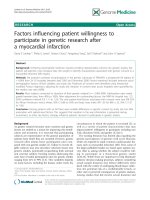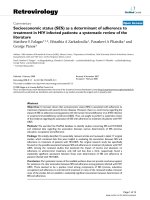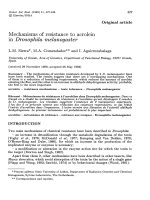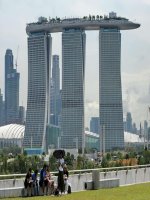Low resistance to resettlement in singapore, 1965 1985 a clumsy approach that overcame a wicked problem
Bạn đang xem bản rút gọn của tài liệu. Xem và tải ngay bản đầy đủ của tài liệu tại đây (1.06 MB, 170 trang )
LOW RESISTANCE TO RESETTLEMENT
IN SINGAPORE, 1965-85:
A CLUMSY APPROACH THAT
OVERCAME A WICKED PROBLEM
ZHENG RENJIE
A THESIS SUBMITTED
FOR THE DEGREE OF MASTER OF SOCIAL SCIENCES
DEPARTMENT OF POLITICAL SCIENCE
NATIONAL UNIVERSITY OF SINGAPORE
2013
i
DECLARATION
I hereby declare that the thesis is my original work
and it has been written by me in its entirety.
I have duly acknowledged all the sources of information
which have been used in the thesis.
This thesis has also not been submitted
for any degree in any university previously.
______________________________
Zheng Renjie
26 Mar 2013
ii
ACKNOWLEDGEMENTS
First and Foremost, I will like to express my gratitude to those
individuals whose sharing made this study possible. They have generously
offered their time and stories. I will like to thank Assistant Professor Erik
Mobrand for his guidance and support for this project. I will also like to thank
the staff of NUS Political Science Department for accommodating to the needs
of a part-time candidate, and for the guidance in the procedures of the thesis
and the IRB submissions. I am indebted to my friends and family who have
provided me feedback of my drafts from proposal to final paper.
iii
TABLE OF CONTENTS
Declaration page………………………………………………………………..ii
Acknowledgements…………………………………………………………....iii
Table of Contents………………………………………………………………iv
Summary…………………………………………………………………......viii
List of Diagrams / Maps ......………………………………………………..….x
INTRODUCTION……………………………………………………………...1
CHAPTER 1: CONTEXT OF STUDY
1.
THE CHALLENGE OF RAPID URBANIZATION…………………..4
2.
URBANIZATION AND POVERTY IN ASIA………………………...5
3.
RESPONDING TO THIS CHALLENGE……………………………...6
4.
3.1
The Challenge of Providing Low-Cost Housing……………….9
3.2
The Challenge of Resettling Slum-Dwellers………………….13
THE SINGAPORE EXPERIENCE………………………………..…19
4.1
Relative Success in Providing Low-Cost Public Housing……19
4.2
Relative Success in Resettling Urban and Rural SlumDwellers…………………………………………………………….…25
5.
LEARNING FROM SINGAPORE………………………………...…28
CHAPTER 2: REVIEW OF LITERATURE
1.
THE EXTENSIVE LITERATURE ON SINGAPORE’S HOUSING
EXPERIENCE………………………………………………………………..34
2.
LITERATURE GAP…………………………………………………..34
2.1
Literature Dealing with Singapore’s Experience with
Resettlement to Public Housing………………………………………35
3.
DATA GAP……………………………………………………………38
iv
3.1
Studies that collected data on Singapore’s Experience with
Resettlement to Public Housing………………………………………38
4.
POSSIBLE CAUSAL VARIABLES EXTRACTED FROM EXISTING
LITERATURE………………………………………………………………...43
CHAPTER 3: STUDY DESIGN
1.
2.
OPERATIONALIZING THE CAUSAL CHAIN…………………….49
1.1
Point A: The Causal Variables…………………….……………..49
1.2
Point B: The Outcome of Responses to Resettlement…………...51
1.3
From Point A to B…………………………………………….51
ARRIVING AT A HYPOTHESIS…………………………………….52
2.1
The Theory of Plural Rationality (Cultural Theory)………….53
2.2
Framing Preferences…………………………………………..54
2.3
Cultural Theory’s Normative Assertion and
Causal Mechanism…………………………………………………….58
2.4
A Case for Clumsiness: Comparing Munich
Birmingham…………………………………………………………...61
2.5
A Causal Mechanism applicable to Singapore’s
Experience?...........................................................................................64
3.
2.6
Is Singapore’s Approach Clumsy?............................................64
2.7
The Hypothesis………………………………………………..69
2.8
Expectations of the Findings………………………………….71
RESEARCH METHODOLOGY…..…………………………………72
3.1
Limitations of Research Design………………………………73
3.2
Design of Interviews……..…………………………………...75
3.3
Sampling…………………..………………………………….79
3.4
Data Collection……………………..………………………...88
3.5
Why the Timeline of 1965-1985……………………………...89
v
CHAPTER 4: THE FINDINGS
1.
SUMMARY OF FINDINGS………………………………………….90
1.1
Summary of Findings for Individual Respondents’ Sentiments
and Beliefs towards Resettlement ……………………………………99
1.2
Summary of Findings for Respondents’ Perceptions of their
Families’, Neighbours’ and Communities’ Sentiments and Beliefs
towards Resettlement …………………………………………….….100
1.3
Summary of Findings for Resistance (or lack thereof) towards
Resettlement ………………………………………………………...100
2.
FINDINGS FOR INDIVIDUAL RESPONDENTS…………………101
2.1
Initial Feelings towards Imminent Resettlement ……………101
2.2
Words describing Initial Sentiments towards
Imminent Resettlement ……………………………………………..102
2.3
Elaboration of Initial Perception towards
Imminent Resettlement ……………………………………………..103
2.4
Change of Sentiments during Transition Phase
of Resettlement …….……………………………………………….110
2.5
Elaboration on the Change of Sentiments during Transition
Phase of Resettlement ….…………………………………………..111
3.
FINDINGS FOR RESPONDENTS’ PERCEPTIONS OF THEIR
FAMILIES’, NEIGHBOURS’ AND COMMUNITIES’ SENTIMENTS AND
BELIEFS TOWARDS RESETTLEMENT..………………………………..112
3.1
Initial Feelings towards Imminent Resettlement …………..113
3.2
Words describing Initial Sentiments towards
Imminent Resettlement ……………………………………………..114
3.3
Elaboration of Initial Perception towards
Imminent Resettlement ……………………………………………..115
3.4
Change of Sentiments during Transition Phase
of Resettlement …….……………………………………………….120
3.5
Elaboration on the Change of Sentiments during Transition
Phase of Resettlement ….…………………………………………..122
4.
FINDINGS FOR RESISTANCE (OR LACK THEREOF) TOWARDS
RESETTLEMENT.………………………………………………………….123
vi
4.1
Presence of Resistance towards Resettlement ………………123
4.2
Elaboration on Resistance towards Resettlement …………...124
4.3
Reasons for Absence of Resistance towards Resettlement ….125
4.4
Elaboration on Absence of Resistance towards
Resettlement…………………………………………………………126
CHAPTER 5: DISCUSSION AND CONCLUSION
1.
A LITERATURE AND DATA GAP ADDRESSED………………...129
2.
TESTING THE HYPOTHESIS ON A CASE STUDY……………..135
3.
LESSONS FOR ASIAN COUNTRIES SEEKING TO LEARN FROM
SINGAPORE’S RESETTLEMENT TO PUBLIC HOUSING
EXPERIENCE…………………………………………………………………..138
4.
CONCLUSION……………...………………………………………145
ANNEX A: SAMPLE OF INTERVIEW FORM……………………………149
BIBLIOGRAPHY…………………………………………………………...154
vii
SUMMARY
Rapid urbanization is a pressing global issue. The number of urban
slum-dwellers living in squalid conditions is growing rapidly. This issue is
especially urgent in fast-growing Asia. The governments of these countries are
attempting, or have attempted, to address the slum problem through providing
alternative low-cost public or private housing. However, the slum-clearance
through resettlement experiences of many countries were fraught with
difficulties like resistance to resettlement, and the failure to provide affordable
alternative housing. In contrast, Singapore's experience since independence
was relatively successful. Urban shophouse and rural kampong slums were
redeveloped with minimal resistance. Most resettlers were resettled into
affordable public housing. There are no slums in Singapore today. This
experience is one that officials from many Asian countries are trying to learn
from.
The lessons from Singapore's slum-clearance and resettlement to public
housing experiences are well-documented. However, there is a gap in the
literature dealing with the resettlement phase. Existing literature records that
Singapore's resettlement to public housing experience was relatively smooth
because of the low level of resistance to resettlement from urban and rural
slum-dwellers.
A review of current literature on Singapore’s housing experience and
related case studies reveals a total of eleven causal variables argued - in
different combinations by authors - to be the reasons behind the relatively
viii
successful slum-clearance through resettlement to public housing program.
These factors are 1) effective supporting policies, 2) strong political support, 3)
availability of 4) quality and 5) affordable housing 6) at a good location, 7)
absence of corruption, 8) fair compensation, 9) a measured approach to
eviction, 10) social and cultural factors, and 11) geographical factors. However,
there is no substantiated discourse on how these eleven causal variables
influenced the outcome of low resistance.
The questions above were not able to be discussed because of a data
gap. There is a lack of studies into the sentiments, perceptions and choicemaking of resettlers before the resettlement. In response, this paper presents a
study that investigated the puzzle of:
How did the multitude of causal variables cited in existing
literature influenced the outcome of a low resistance to
resettlement to public housing in Singapore between 1965 and
1985?
Drawing from a normative assertion of Cultural Theory, which argues
that a “clumsy” approach to “wicked” problems will influence a positive
outcome, an ethnographical study was conducted to validate the hypothesis of:
The eleven factors shaped the outcome of low resistance
because the totality of factors constituted a clumsy approach
which avoided the pitfalls to a viable resettlement to public
ix
housing program. The resulting program catered to the
multitude of resettler preferences and deterred the realization
of any preference to resist.
This study shows that firstly, the eleven factors constituted a clumsy
approach. Secondly, this clumsy approach enabled Singapore to avoid the
pitfalls that halted resettlement programs in other Asian countries. Thirdly, the
findings validate that the resettlement program catered to the multitude of
preferences for resettlement, and deterred any preference for resistance.
x
LIST OF DIAGRAMS / MAPS
Diagram 3.1: How Preferences are Derived………………………………..…52
Diagram 3.2: The Grid-Group Typology……………………………………...56
Diagram 3.3: The beliefs, values, strengths and weaknesses
of each way of life…………………………………………………..………...57
Diagram 3.4: Diagram showing how Singapore’s approach was clumsy….....65
Diagram 3.5: Graph showing Year of Birth of Respondents………………….82
Diagram 3.6: Graph showing Year of Resettlement of Respondents…………83
Diagram 3.7: Map showing Location of Respondents’ Residences Prior to
Resettlement…………………………………………………………………..84
Diagram 3.8: Map showing Location of Respondents’ Residences prior to
and after Resettlement ...……………………………………………………..85
Diagram 3.9: Graph showing Resettlement Status of Respondents…………..86
Diagram 3.10: Graph showing Number of People Respondents can speak for.87
Diagram 3.11: Graph showing Ethnicity of Respondent…………………..….88
Diagram 4.1: Summary of Findings organized in the Grid–Group Framework..91
Diagram 4.2: Table depicting how respondents’ reasons for preference are direct
outcomes of resettlement policies or contextual endowments in the
Egalitarian Context……………………………………………………………….92
Diagram 4.3: Table depicting how respondents’ reasons for preference are direct
outcomes of resettlement policies or contextual endowments in the Hierarchical
context…………………………………………………………………………….93
Diagram 4.4: Table depicting how respondents’ reasons for preference are direct
outcomes of resettlement policies or contextual endowments in the Individualist
context…………………………………………………………………………….95
Diagram 4.5: Table depicting how respondents’ reasons for preference are direct
outcomes of resettlement policies or contextual endowments in the Fatalist
Context……………………………………………………………………………96
Diagram 4.6: Table depicting how the eleven causal themes, in totality, constituted
a clumsy approach………………………………………………………………..98
Diagram 4.7: Graph showing Respondents’ Scale of Feelings towards
Imminent Resettlement.……………………………………………………102
xi
Diagram 4.8: Graph showing Respondents’ Words describing Feelings towards
Imminent Resettlement.……………………………………………………102
Diagram 4.9: Graph showing Respondents’ Key Reasons for
Perception towards Imminent Resettlement ………………………………104
Diagram 4.10: Graph showing Respondents’ Change of Sentiments during
Transition Phase of Resettlement ………………………………………….110
Diagram 4.11: Graph showing Scale of Feelings towards Imminent
Resettlement ……………………………………………………………….114
Diagram 4.12: Graph showing Words describing Feelings towards Imminent
Resettlement.……………………………………………………………….115
Diagram 4.13: Graph showing Respondents’ Perception of their Families’,
Neighbours’ or Communities’ Primary Reasons for their Sentiments towards
Imminent Resettlement …………………………………………………….116
Diagram 4.14: Graph showing Respondents’ Perception of their Families’,
Neighbours’ or Communities’ Secondary Reasons for their Sentiments towards
Imminent Resettlement …………………………………………………….117
Diagram 4.15: Graph showing Change of Perception during Transition Phase
of Resettlement …………………………………………………………….121
Diagram 4.16: Graph showing Resistance towards Resettlement …………124
Diagram 4.17: Graph showing Reasons for Absence of Resistance towards
Resettlement ………………………………………………………………..126
xii
INTRODUCTION
Rapid urbanization is one of the most pressing global issues affecting
the human condition today. The population of slum-dwellers are growing
rapidly in cities, placing large numbers of people in unacceptable squalid
conditions. In fast-growing Asia - where rural to urban migration follows the
trajectory of economic growth, this problem can only get worse. The
governments of these countries are attempting, or have attempted, to address
this problem through resettling these slum-dwellers to low-cost public or
private housing. However, the slum-clearance and resettlement to low-cost
housing experiences of many countries are fraught with difficulties. These road
blocks range from resistance to resettlement1 to the governments’ inability to
meet the demand for affordable alternative housing.
In contrast, between 1965 and 1985 (the first 20 years of Singapore's
post-independence slum-clearing through resettlement to public housing
endeavours), Singapore’s experience was relatively successful. Urban
shophouse slums and rural kampong2 slums were redeveloped with minimal
resistance. The majority of the slum-dwellers were resettled into affordable
public housing. Today, there are no slums in Singapore – save for the few
1
This paper uses the term “Resettlement” as a more appropriate term to describe the program
under study here. Terms like “Relocation” or “Reestablishment” do not accurately capture the
nature of the move to a new dwelling type. People affected by resettlement will be referred to
as “Resettlers”.
2
The term “Kampong” is used in this paper to refer to a village or community in the sub-urban
or rural areas of Singapore. There is no differentiation between a Chinese or Malay Kampong.
The individual houses in Kampongs will be referred to as “Kampong houses”; and the
occupants of these kampong houses will be referred to as “kampong-dwellers”. Kampongs in
Singapore were considered to be slums due to their squalid conditions and unplanned nature of
their development.
1
kampong dwellings that were conserved. This experience is one that officials
from many countries are trying to learn from. As the majority of these countries
are Asian, this paper will focus on comparing the experiences of Singapore and
these Asian countries.
The lessons that these Asian countries can learn from Singapore's slumclearance and resettlement to public housing experience are well-documented
in areas of policy, satisfaction of living conditions and environment, homeownership schemes, ethic-quotas for purposes of nation-building, and even
housing as political legitimacy, to name a few. The literature records that
Singapore's resettlement to public housing3 experience was relatively
successful because of the low level of resistance to resettlement from urban and
rural slum-dwellers. However, there exists a gap in the literature dealing with
the resettlement phase.
A review of current literature on Singapore’s housing experience and
related case studies reveals a total of eleven causal variables argued - in
different combinations by authors - to be the reasons behind the relatively
successful slum-clearance through resettlement to public housing program.
These factors are 1) effective supporting policies, 2) strong political support, 3)
availability of 4) quality and 5) affordable housing 6) at a good location, 7)
absence of corruption, 8) fair compensation, 9) a measured approach to
3
This paper is careful to distinguish between “resettlement and public housing efforts /
endeavour / programs” with “resettlement to public housing efforts / endeavour / programs”.
The former is used when resettlement and public housing are discussed separately as each is a
massive undertaking in their own right. For example, a country might embark on a resettlement
program from one private urban estate to another; while another might actually be following
Singapore’s example of resettling from private dwellings to public housing. The “resettlement
to public housing” phrase will be used to describe programs similar to Singapore’s.
2
eviction, 10) social and cultural factors, and 11) geographical factors. However,
there is no substantiated discourse on how these eleven causal variables
influenced the outcome of low resistance. In other words, how did the list of
factors above influenced the choice of resettlers to either volunteer for
resettlement or not resist forced resettlement? Which factor played a bigger
role? Also, as no authors cited the same combination of variables in their work,
is there a certain combination of variables that is sufficient for low resistance,
or are all variables necessary?
The review of existing literature also reveals that the questions above
were not able to be discussed because of a data gap. There is a lack of studies
into the sentiments, perceptions and choice-making of resettlers before the
resettlement. While there were quite a few studies conducted to investigate the
sentiments of resettlers when they were in their new public housing dwellings,
there are no studies that investigated why they did not resist the move in the
first place.
These literature and data gaps need to be addressed because the
knowledge of the conditions needed for low resistance to resettlement will aid
developing countries’ current slum-clearance and resettlement to low-cost
housing efforts to mitigate the effects of rapid urbanization. Simply knowing
the factors, and then installing them without understanding of the causal
mechanisms behind how the factors influenced the outcomes, may not replicate
another successful experience. Only by understanding the causal mechanisms
can policy-makers from countries learning from Singapore adapt what they
3
learned to their context.
In response, this paper presents a study that investigated the puzzle of:
How did the multitude of causal variables cited in existing
literature influenced the outcome of a low resistance to
resettlement to public housing in Singapore between 1965 and
1985? What is the causal mechanism(s) that allowed the
variables to shape the outcomes?
This paper will be presented in five chapters. Chapter 1 sets the context
of the study and reviews the experience of Asian countries conducting slumclearance through resettlement to low-cost housing. The discussion of their
experience will be divided into two main themes: the challenges of providing
low-cost alternative housing, and the challenge of resettling slum-dwellers.
Likewise, it also presents an overview of the slum-clearance through
resettlement to public housing programs of Singapore in these two themes.
Chapter 2 reviews the literature and data on Singapore’s resettlement to public
housing phase. Existing explanations, the literature gap and the data gap will
be discussed. Chapter 3 presents the design of the study - outlining its
objective, hypothesis, research method, sampling, and data collection. Chapter
4 presents the survey findings. Chapter 5 presents the analysis of the data, and
an attempt to respond to the topic question.
4
CHAPTER 1:
CONTEXT OF STUDY
______________________________________________________________________
1.
THE CHALLENGE OF RAPID URBANIZATION
Rapid urbanization is a contemporary global issue that requires urgent
attention. The world urban population is expected to increase by 84 per cent by
2050, from 3.4 billion in 2009 to 6.3 billion in 2050.4 Half of humanity now
lives in cities, and within two decades, nearly 60 per cent of the world’s people
will be urban-dwellers. “With more than half of the world’s population now
living in urban areas”, says Mr Ban Ki-moon, the Secretary-General of the
United Nations, “this is the urban century”.5
Anna K. Tibaijuka, Under-Secretary-General and Executive Director of
United Nations Human Settlements Programme at UN-HABITAT, tells us that
“urban growth is most rapid in the developing world, where cities gain an
average of 5 million residents every month”.6 Mr Ban adds that “cities embody
some of society’s most pressing challenges, from pollution and disease to
unemployment and lack of adequate shelter.”7 Most cities are unable to provide
formal housing for these new residents. Consequently, informal settlements
like slums and shanty towns grew rapidly. Such informal settlements
compounds further the already strained urban conditions. For example, as Ms
Tibaijuka states:
4
World Urbanization Prospect,
UN Habitat. (2008). State of the World’s Cities 2008/2009. London: Sterling
6
Ibid.
7
Ibid.
5
5
“The world is also confronting the challenge of increasing
disparities between the rich and the poor… urban inequality has a
direct impact on all aspects of human development, including
health, nutrition, gender equality and education. In cities where
spatial and social divisions are stark or extreme, lack of social
mobility tends to reduce people’s participation in the formal
sector of the economy and their integration in society. This
exacerbates insecurity and social unrest which, in turn, diverts
public and private resources from social services and productive
investments to expenditures for safety and security.”8
2.
URBANIZATION AND POVERTY IN ASIA
The lack of access to housing is one of the most serious and widespread
consequences and causes of poverty. This problem is most pressing in Asia
(Yuen, 2007). The largest proportion of the one billion people living in slums in
the world is in the Asian region. About a quarter of the total urban population
in Asia is living below the poverty line - although the proportion may be higher
in some countries. India and China each holds about a third of the region’s
urban population with many living in relative poverty (Jacquemin, 1999). In
South Asia, slum and squatter settlement population constituted 58% of total
urban population compared to 36.4% in East Asia and 28% in Southeast Asia.
Of the 12 million people in Mumbai, for example, about 50 per cent lives in
slums, dilapidated chawls and on pavements (Yuen, 2007).
8
Ibid.
6
This challenge in Asia will continue to grow. Giok (2007) tells us that
“the estimates are that more than 60% of the increase in the world’s urban
population over the next three decades will be in Asia, mostly in China and
India, but also in Pakistan, Bangladesh, the Philippines, and Vietnam. Nine out
of 23 cities with populations of more than 10 million people are in Asia.” Many
Asian countries are struggling to cope with this growth. For example, in Ho
Chi Minh City in Vietnam, the Government and private developers struggle to
house the new 50,000 migrants and 20,000 young urban households every year.
Consequently, squatter and slum settlements now constitutes 15% of housing in
the city (Giok, 2007).
3.
RESPONDING TO THIS CHALLENGE
In response to the challenge of alleviating poverty and other social
problems caused by rapid urbanization, Governments in Asia have for the past
few decades been seeking to clear urban slums by taking over the land, evicting
squatters, and providing low-cost housing for the urban poor. In Bangkok,
Thailand, the Government set up the National Housing Authority (NHA) in
1973 to build public housing in various forms - like high-rise apartments to
terrace houses - to house evicted slum-dwellers (Yap, 1992). In Malaysia, the
Government implemented a Special Low-cost Housing Scheme in 1985, with a
target to build 80,000 low-cost houses annually for three years (1986-1989)
(Khor, 1989: 8). In India, under the National Government Clearance and
Resettlement Scheme, resettlement projects were carried out throughout India.
(See Baken, 2003, for case studies). Up to 1983, the Government took care to
7
ensure nearly all new settlements were located near to their source settlements
(324).
In Hong Kong, due to the sudden influx of migrants in the late 1940s
and the early 1950s, there is a “rapid growth in size of the squatter population
which at one time constituted up to 25% of the entire population” (Wong,
1978: 206). The government set out to clear the slums and resettle squatters
with considerable success. In the 1960s and 70s, a massive resettlement
programme shifted a majority of the population out of Hong Kong City (Fung,
1978: 233). Since then, Hong Kong is “one of the very few countries where
squatter population has been decreasing in size” (Wong, 1978: 206). In Manila
in the Philippines, as early as 1949, “the Filipino Government launched public
housing programs designed for low-income families and to accommodate
evicted squatters” (Einhart, 1989: 13). When it failed, an ambitious project,
Urban BLISS, was launched in 1979 to “develop depressed areas into model
communities” of public housing (Ibid).
In Jakarta in Indonesia, the Public Works Department set up
PERUMNAS, a quasi-governmental consulting firm in 1974, to “help central
and municipal governments supply low-cost housing, core housing and siteand-services schemes” (Einhart, 1989: 30). In South Korea, from the 1960s to
the 80s, the Government embarked on slum-clearing through resettlement to
low-cost housing endeavours, particularly in Seoul (Mobrand, 2008). For
example, from 1967 to 1971, officials led giant low-income housing projects
like “The Citizens’ Apartments” project which involved building 90,000 units
8
in 2000 apartment buildings for evicted slum-dwellers (376). In Cambodia, the
Government “has accepted housing as a critical means to achieve the goals of
poverty reduction of its population specially the urban poor who live
prevalently in Phnom Penh.” It is developing the National Housing Policy, and
committing to a range of “guiding policies and commitments, including a
Hundred Settlements Policy, to improve housing conditions of people to meet
their basic needs for shelter…” (Bunnarith, 2004).
In July 2012, ahead of the World Cities Summit in Singapore, Sri
Lankan mayor Danasiri Amarathunga tells us that “there are a lot of shanty
areas, squatters in Colombo city. We'll have to move them out, (but) we have to
keep them inside Colombo city also for their work purposes.”9 In China,
Municipal Governments set up Housing Settlement Project Offices to work
with the Ministry of Construction to develop housing settlements. For example,
the Shanghai Housing Settlement Project Office has since 1987 been resettling
households to public housing.10 Meanwhile, Myanmar plans to build more than
a million residential flats from 2013 to 2028.11
In the next sections (3.1 and 3.2), this paper will discuss the challenges
faced by these Asian countries when conducting the two efforts that are critical
for any slum-clearing efforts to work: providing low-cost alternative housing,
and the delicate task of resettling slum-dwellers.
9
Channel News Asia Online, “Poverty, pollution, infrastructure are key urban challenges: Lee
Yi Shyan”, 01 Jul 2012, available at
< />10
Shanghai Housing Settlement Project Office, Housing Settlement Project in Shanghai,
available at < />11
“Myanmar plans to build 1M flats in 15 years”, Eleven Online, 26 Oct 2012, available at
< />
9
3.1
The Challenge of Providing Low-Cost Housing
The governments that undertook the task of providing low-cost housing
for the urban poor would have found out that this task is a challenging one. It is
not a straight forward building endeavour. Many Asian governments found it
difficult to sustain a low-cost housing program. For example, the Government
of Thailand encountered difficulties when it embarked on a Five-Year Plan
(1976-1980) to construct 120,000 heavily subsidised housing units in Bangkok
through the National Housing Authority (NHA). In the first three years, NHA
constructed 36,868 apartments (Yap, 1992: 13). However, the project was
cancelled in 1978 as it was deemed overambitious and unaffordable. A new
plan, the Accelerated Plan 1979-1982, was initiated. However, this plan was
abandoned too due to the reduced subsidies by the Thai Government.
Consequently, to build up its ability to fund new projects to house the slum
evictees, NHA started building houses for middle to upper-income Thais. But
as the houses compete poorly with private housing, NHA was unable to build
up the necessary funds to conduct what it was set up to do. As such, the impact
of NHA on slum conditions in Bangkok was limited.
Likewise, the Government of Malaysia encountered similar difficulties.
Malaysia’s Special Low-cost Housing Scheme in 1985 was problematic as a
large part of the population could not afford the houses. Khor (1989) tells us
that “the crux of the housing problem is that the country’s building resources
were channelled not towards where people’s needs are, but towards where the
market which could pay was” (9). This was a consequence of the nature of
10
Malaysia’s system of providing low-cost housing, where private developers
constitute a significant part of the endeavour. Most of the houses built by
private developers are not catered to the low-income group. For example, the
Third Malaysian Plan indicated that “hardly 1.1% of the 64,900 units built by
private developers (in 1971-1975) can be considered low-cost” (20).
Furthermore, the high cost of housing is also “contributed by the policies of
financial institutions as well as manufacturers of building materials” (40).
Another problem that arises from Malaysia’s system of engaging
private developers to build public houses is that of abandonment of projects. In
1987, there were 184 abandoned housing projects involving more than 30,000
houses (32). There are several reasons for such abandonments. In some cases,
developers absconded with the 10% down-payment paid up front. Other
reasons include “financial problems, conflicts or problems with Government
agencies; or lack of experience and management; or progress payments from
buyers are not used for the projects but instead channelled towards share
speculation or given as loans to others, thus leading to shortage of money; or
the company is in liquidation because of failure to settle debts” (Harun Din,
1987: 52).
As a result of the failures of the private developers to meet the targets
of providing housing for the poor, in the 1990s, the Government directed the
Employees Provident Fund (EPF) to “undertake large scale low and medium
cost housing… meant to send a message to private developers that the
Government would no longer tolerate the alleged excessive profits reaped by
11
private housing developers who did not reciprocate by building low cost
housing required by government policy and conditions of approval” (Salleh,
Lee, 1997: 1). However, this initiative did not work as the private developers
have no incentive to provide cheap housing when the Government kept
building them.
In South Korea, from the 1960s to the 80s, the Government was unable
to resolve the squatter problem through resettling slum dwellers to low-cost
housing. In 1961, weeks after the coup that instated a new government,
“thousands of illegal shacks were removed and the new government promised
new housing for many of their occupants” (Mobrand, 2008: 374). However,
public housing units were either insufficient to meet demand, or were too
expensive for evicted slum-dwellers to afford. In the years that followed,
thousands of evicted households were instead resettled to rural areas to reclaim
agricultural land, and to work sites. Only 17,000 were relocated to apartments.
Some 47,000 households were even resettled to detention camps on the
outskirts of the city (Ibid).
The Citizens’ Apartments project that the Government embarked on in
1967 did not fully fulfil the intent to house evicted slum dwellers. Research
shows that less than half of the apartments were occupied by evictees (337).
Many evicted households were priced out of the housing. Worse still, one of
the apartments collapsed, leaving 33 dead. The collapse was a result of corrupt
officials who allowed “cheap, low-grade materials to be used” (Ibid). Plans for
further building were promptly scrapped when 61 other apartments were found
12
to be dangerous (378). Another ambitious project, the Kwangju Housing
Complex, was initiated as a satellite city to cater to displaced evictees in 1968.
However, while the population of Kwangju swelled up to 27,000 in 1970, basic
amenities like water, electricity, housing and food were in short supply.
Families relocated to Kwangju “were continuing to move back to Seoul” (Ibid).
Eventually, Kwangju was to be taken over by middle to upper class citizens
due to the Government’s system of allowing private developers to develop the
city, effectively pricing out poorer slum-evictees (378, 379).
Housing prices continued to increase rapidly in the 1980s. Housing
costs as a proportion of total family expenditure in South Korea “increased
from 15.2 percent in 1978 to 29.9 percent in 1988” (MMUY, 1990: 50, 51).
This was a consequence of the Government’s reliance on the private sector to
provide housing to the population. The expenditure on housing only constituted
0.86 percent of the South Korean Government budget, compared to, for
example, Singapore’s 14.32 percent (Park, 1998: 276) and India’s 14.32
percent (277). Furthermore, the housing financing system impeded the poorer
families from being able to overcome the high prices through housing loans.
The housing loans granted only accounted for 22.8 percent of housing prices
(KRIHS 1990: 89).
Lastly, in the Philippines, the Government’s public housing program
launched in 1949 failed in providing mass low-cost housing for the poor. The
reasons for this failure includes financial constraints, indebtedness,
mismanagement, corruption, unaffordability of houses, rising costs of
13



